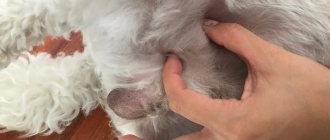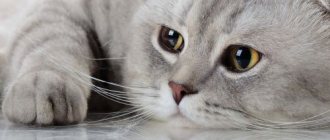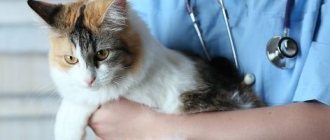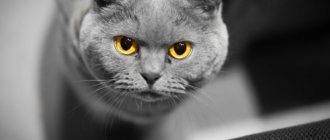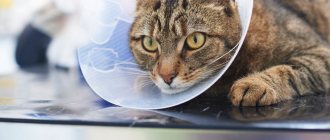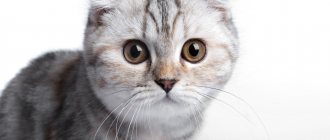Castration - pros and cons of the procedure
Puberty in cats requires the creation of certain conditions. Not all owners have this opportunity. When testosterone is produced in a pet (as nature dictates), the reproductive instinct awakens, which affects the animal’s behavior.
Since testosterone is produced on a regular basis, mating of the pet should not occur randomly, but regularly. According to veterinary reports, this should happen every 2 or 3 weeks. Violation of the cycle leads to deterioration in the health of the animal. Therefore, the only option is to reduce testosterone levels, which occurs after castration.
In urban apartment conditions, it is practically impossible to solve such problems. It is good when the animal is accustomed to the street and can independently cope with natural instincts. But these are completely different conditions: private, low-rise houses, dachas, etc.
Benefits of the operation
- life expectancy increases by 1.5 - 2 years, since the animal is protected from possible infectious infections and surges in the hormonal system;
- the pet stops marking indoors;
- The cat's behavior becomes calmer and more balanced.
Consequences of the operation
After castration, the following consequences may occur:
- in some cases, the pet’s activity decreases (here it is important to choose the appropriate diet);
- the possibility of having offspring is excluded;
- the effects of anesthesia may impair heart function.
Treatment of the wound
The surgeon deals with a wound resulting from an operation in two possible ways:
- Places stitches. This method is less common these days and is used for cats that have problems with blood clotting.
- Treats the wound with brilliant green and lets it heal on its own.
Accordingly, care for the resulting wound depends on the method of its healing. If there are seams, it is recommended to treat them twice a day with hydrogen peroxide and re-lubricate them with brilliant green. Most modern veterinary clinics use absorbable sutures that do not require their removal.
In most cases, re-treatment of a healing wound with green is not required.
Wounds that remain open do not require self-care unless there are obvious signs of complications
The only difficulty that the owner may encounter is the animal’s excessive attention to its wound. Licking an unprotected area of flesh is undesirable and can lead to infections.
That’s why special collars are put on overly active pets.
Prevent bleeding
Blood and ichor may leak out for several days after surgery. Blood can either concentrate in the scrotum area or flow down the hind limbs. To prevent excessive bleeding, it is permissible to use Dicinone, which improves blood clotting.
Dicinone helps reduce bleeding
The drug is available in the form of tablets and solutions - in our case, it is the solution that is needed. Injections are given intramuscularly, 0.1 ml of the substance per 1 kg of pet’s weight. The optimal place for the injection is the thigh. In addition to injections, it is recommended to apply an ice pack to the wound for ten minutes, four times a day.
Possible complications after castration
Recovery after surgery occurs individually for all individuals, but it is important to sense in time the line between normal and a dangerous condition that requires intervention. According to the time of manifestation of complications, they are divided into two types
Early - they appear even before you have time to leave the clinic with the animal. Sometimes the first signs of problems make themselves felt on the operating table. Most often, such complications include bleeding and prolapse of the organs closest to the incision (testes, omentum, etc.)
This is why post-operative recovery is important to allow the pet’s health to stabilize;
Late ones - they make themselves felt after the cat is at home and begins to come to his senses. As a rule, late complications are associated with the penetration of pathogenic microbes into the healing wound, causing inflammatory processes
Poorly washed scrotum before the operation, unhygienic instruments, violation of the rules for transporting the animal - all this can cause further health problems.
It is possible to identify the presence of an infection in a cat’s body without a thorough study of its anatomy. Of course, when a section of the intestine prolapses, the diagnosis is obvious, but there are also less obvious, but no less dangerous options. It is enough to note a few main symptoms:
- body temperature rises by 1.5-2 degrees;
- stiff gait resulting from discomfort in the perineal area;
- lack of appetite and lethargy for several days;
- tense abdomen, painful on palpation;
- difficulty urinating;
- purulent discharge from the wound;
- shortness of breath, rapid heartbeat.
If the above signs are present, it is necessary to contact the doctor who performed the operation and describe in detail the animal’s condition in order to develop further actions.
Indications and contraindications for the procedure
It is important for the owner to know and understand that the castration procedure is not suitable for all pets. In some cases, this operation is contraindicated or requires an individual approach. Such cases include: liver and kidney failure, heart and vascular diseases, anemia, exhaustion, as well as age restrictions.
In some cases, veterinarians insist on carrying out a castration procedure. For example, with such a pathology as cryptorchidism. Cryptorchidism is a congenital pathology in which one or two testicles do not descend into the scrotum. The animal may suffer from pain in the abdomen or groin area. Sometimes cryptorchidism leads to tumors in your pet. Therefore, castration in this case is extremely necessary.
The average price for an operation varies from 800 to 1500 rubles, excluding anesthesia. The total costs of the procedure, medications and other needs depend on the region of residence, the clinic and the characteristics of the animal. Sometimes the price can reach 5000 or 8000 rubles.
Suitable age for castration
The permissible age for castration of a cat is from 7 months to 6 – 7 years. Veterinarians recommend operating on an animal between 7 and 9 months. Up to seven months, the kitten’s body is still developing and premature intervention can lead to diseases of the genitourinary system.
The period from 7 to 9 months is considered favorable for surgery, since the pet reaches puberty and is already able to tolerate anesthesia.
Sometimes puberty occurs during the kitten's fifth or sixth month. In this case, you need to consult a veterinarian.
By 12 months, the cat reaches sexual maturity and hormonal levels change. Testosterone is produced by both the testes and adrenal glands. Surgery at this age will not lead to a decrease in testosterone immediately, but only after 1 to 3 months.
The mature age of a pet is 5 – 7 years. At this age, anesthesia has an effect on the pet’s body.
After 7 years, the animal enters the elderly stage. A thorough examination by a veterinarian is required before the procedure. If there are any violations, the veterinarian suggests a medicinal method of castration.
Castration at this age can cause a number of complications:
- accidental urination;
- the cat takes longer to recover from anesthesia;
- after castration, diseases of the testes may occur;
- pronounced psychological and physical stress, since the elderly cat had the opportunity to mate more than once;
- There is a risk that a mature cat will retain some habits after surgery, such as marking his territory.
Castration of an adult cat can lead to undesirable consequences and suffering, primarily for the pet. Owners should remember this.
Before making a decision regarding your pet's surgery, you need to weigh the pros and cons!
Should a cat be neutered?
Owners of fluffy cats are divided into 2 camps: some castrate their cats, others leave the entire range of functions to the animal, often even if the cat will live exclusively in the apartment, without participating in the reproduction of offspring.
A lot depends on the cat’s behavior:
- Some cats are active and, upon reaching puberty, begin to display active territorial and sexual behavior - they mark their territory, sing, and jump after cats from windows and balconies. Sometimes cats begin to perceive the owner as a potential partner - and those around them begin to be perceived as potential rivals. Also, sexual hunting can be sublimated with furnishings and toys.
- There is another type of cat who, from a young age, lived in an isolated room; the cat was not “showed” to them. The sexual instinct of such animals is “not activated” due to the absence of an object of desire.
A frequently asked question to a veterinarian:
Is it worth castrating a cat, or can castration be avoided for a phlegmatic pet that does not mark its territory and does not harass its owners?
We examine the issue in detail in this article:
Basically, castration is aimed at limiting the reproduction of animals with genetic disorders that have deviations in the breed standard. This includes a whole list of selection criteria. If your pet is purebred, but you do not plan to get offspring from it, then it is better to castrate the cat at a young age.
The operation also has medical indications: for cats it is oncology of the gonads, testicular injuries, urolithiasis, excessively aggressive behavior due to sexual desire.
It is important to understand!
If the problem is behavioral disorders, then surgery may not solve the problem. Owners should be prepared for the fact that they will have to look for a way out based on animal psychology.
After the operation, the pet will need care, a properly balanced diet and daily physical activity, since the reduced level of testosterone will contribute not only to a calm nature, but also to a decrease in physical activity, which will affect the metabolic rate.
Some owners castrate cats “for prevention.” This is justified if there are problems in the animal's family history. You know for sure that the kitten’s parents had urolithiasis or genital cancer.
Optimal age for castration
Everything must be on time. Testosterone is responsible not only for puberty, but also for the development of the kitten’s muscles and its constitution.
Popular opinion
Many owners are afraid that if the cat starts to mark the territory or manages to “smell gunpowder”, then it will be unstoppable.
This statement falls into the category of common myths.
Most owners turn to the veterinarian when the cat is between 2 and 3 years old. The pet is in its prime, hormones are seething in it and patterns of behavior have already formed, which the cat perceives as a “natural imperative.” Attempts by owners to ignore their pet's needs result in urination on shoes, furniture, belongings, and even the owners themselves.
It is important to know!
If you want your pet’s body to develop, but the household member does not experience the delights of sexual heat, it is better to castrate the cat at the age of 6-8 months.
Castration at a later age can often be associated with injury or disease. Unneutered cats actively participate in territorial fights with their relatives and can get not only wounds, but also infection. Wandering during sexual desire often results in lost time for treatment.
When castrating a cat over 10 years of age, problems with oncology are added. Here the situation is complicated by the fact that the animal may be weakened by concomitant diseases - problems with the cardiovascular system, kidneys. These are contraindications for surgery.
Castration methods
When it comes to surgery, there are three types of castration: open, closed and vasectomy.
- The open method of surgery is the most common. In this case, the scrotum is stretched and an incision is made in the skin and general vaginal membrane. After this, the tunica vaginalis is cut off from the epididymis and the spermatic cord is removed. A ligature is placed on the cord. A similar procedure is carried out with the second testis.
- The closed method is most relevant for old cats or pets with congenital enlargement of the inguinal rings. To begin with, the scrotum is also stretched, but the incision is made only on the skin. The tunica vaginalis is removed from the wall of the scrotum. The membrane and testis are rotated 180 degrees and stitched with thread. Then a ligature is applied and the testis is cut off just below it. A similar procedure is carried out with the second testis.
- Vasectomy is a method that does not require general anesthesia; local anesthesia is used. Bilateral segmental ligation of the vas deferens is performed. Through these channels, sperm are discharged into the urethra. With this method, the pet’s hormonal levels are not disrupted and sexual reactions are preserved.
There are also non-surgical types of castration:
- Chemical castration involves the introduction of a special injection that suppresses the pet’s sexual desire.
- Microwave castration is done using irradiation. The method is painless, but its consequences have not been fully studied. Therefore, this method is rarely used nowadays.
- Chemical castration using the Suprelorin implant suppresses desire and causes infertility six weeks after insertion. The implant is given to the pet using an injection.
The benefit of chemical castration is that the pet does not require special training, there is no rehabilitation period and there is no risk from anesthesia. But at the moment, the reactions and consequences of such castration have not been fully studied.
Types of anesthesia
For castration, local or general anesthesia is used. Local anesthesia is used locally, on a specific area of the body, or the anesthetic is injected into several points on the body. After local anesthesia, the pet’s body recovers faster. Anesthesia is administered using a syringe.
General anesthesia involves certain risks to your pet's health. Before applying general anesthesia, the animal must be examined and checked for failures and disturbances in the functioning of the cardiovascular system.
During general anesthesia, anesthesia is administered in two ways:
- Injection method - the medication is administered intramuscularly or intravenously. Intravenous administration provides a quick effect and you can begin to act in 1 – 2 minutes. When administered intramuscularly, the anesthesia begins to act only after 20 minutes. This method can cause complications on the body. As a rule, it is used in relation to aggressive animals.
- The inhalation method involves administering anesthesia through the lungs. This type of anesthesia causes virtually no harm to the body. The risks are minimal. Recovery from anesthesia occurs in 3–4 minutes.
A combined method of anesthesia can also be used for castration. When it is necessary to immobilize a pet, they first use a sedative and then insert a tube into the mouth (in the case of the inhalation method).
Preparing your pet for surgery
Prepare the cat for castration in advance. 2 - 3 weeks before the procedure, the pet must be given anthelmintic drugs.
A preliminary examination by a veterinarian is required. The veterinarian must check the functioning of the genitourinary and cardiovascular systems, prescribe blood, urine and feces tests, and also check for routine vaccinations.
At least 30 days must have passed since the last vaccination!
10 - 12 hours before the procedure, the pet is stopped feeding, as anesthesia can cause a gag reflex. You can give some water.
It is also necessary to prepare a carrying bag, diapers, wet and dry wipes.
What does cat castration surgery include?
Your cat will be put under general anesthesia.
The animal must be fasted for 8 hours before surgery.
You will need to keep your cat off food for 8 hours before surgery. At this time, he can only have free access to water. Your veterinarian will provide recommendations regarding your pet's preoperative preparation.
In cats, both testes are removed through small incisions in the scrotum. Because the incisions are very small and the suture material can irritate the sensitive skin on the scrotum, sutures are almost never used.
Caring for a cat after surgery
The operation lasts on average 15 – 20 minutes. If the event took place at a veterinary clinic, the pet must be met and placed in a carrier. Some call a doctor to your home to perform an operation.
During transport, the pet should lie on its side, since recovery from anesthesia may cause vomiting.
Recovery from anesthesia lasts from 2 hours to a day. It all depends on the age of the pet and its state of health.
The owner must provide the following conditions for the pet:
- While sleeping, cover your pet with a warm blanket or towel (body temperature after surgery drops to 36°C);
- put a bowl of water;
- change body position every 30-60 minutes to restore blood circulation;
- moisten the cornea of the eyes with a special solution every 30 minutes, since the pet sleeps with its eyes open during anesthesia;
- treat the wound for 5 - 7 days with peroxide or chlorhexidine.
During the first day, the pet's coordination is impaired, and he may fall or go past the tray. In this case, the owner needs to treat this with understanding and not scold the animal.
To prevent your pet from licking the wound, it is recommended to wear a special collar, which can be purchased at a pharmacy.
You can start feeding no earlier than 20 hours after surgery. At first, you can give your usual food. In the future, you need to switch to specialized food for neutered cats.
Bathing your pet is allowed 14 days after surgery. By this time, the stitches and wounds should heal.
Further rehabilitation
The effects of anesthesia are clearly felt by the owner over the next 10-16 hours. Cats experience awakening from anesthesia individually, so it is impossible to say exactly when the animal will finally come to its senses. It is necessary to maintain control even after a few days, since residual effects after anesthesia, such as loss of coordination or dizziness, will make themselves felt.
Even though your pet's condition improves, remain vigilant and don't lose sight of him.
Some cats are overexcited during recovery. They rush around the apartment, meow loudly and climb on everything they can. You can't take your eyes off such individuals. Other animals tend to hide in a quiet, dark corner and wait out their unstable state there. Don't bother them again and let them be alone with themselves.
Possible complications after castration
During the first week, your pet's condition should be closely monitored.
Complications may occur in the suture area. Bleeding may begin. The owner should immediately call a veterinarian. A yellow or greenish purulent inflammation may appear. In this case, the pet is given antibiotics to avoid sepsis.
Swelling in the scrotum area can occur when germs enter. To relieve swelling, veterinarians prescribe antibiotics.
Proper preparation for castration, the appropriate age of the pet, as well as careful and careful care will help to avoid complications and risks! It is important to remember that we are responsible for those we have tamed!
